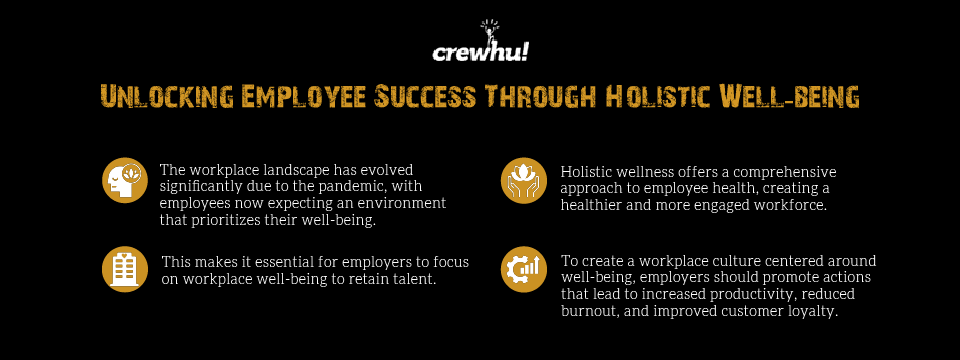Unlocking Employee Success Through Holistic Well-Being

Uncover the transformative power of prioritizing holistic well-being in the workplace, where increased productivity, reduced burnout, top-tier talent attraction, and soaring revenue await.

The workplace landscape has undergone significant transformations since the onset of the pandemic. Nowadays, employees expect their workplace environments to mirror the care and well-being they experience in other facets of their lives. Employers who fail to prioritize their employees’ well-being find retaining talent challenging.
Workplace health has become a prominent topic in today’s digital age, sparking discussions across various online platforms. Everyone seems to have an opinion on exactly which aspects of wellness that companies should emphasize. While specialized interventions like mental health support are undoubtedly valuable, they tend to address symptoms rather than tackle the root causes of issues.
This is where holistic wellness comes into play, advocating for a comprehensive approach that supports all aspects of an individual’s needs instead of focusing on just one or two areas. Holistic wellness encompasses all nine pillars of well-being, ranging from physical and mental health to financial and environmental considerations.
This article takes a closer look at those nine pillars, how to create a culture of well-being in your organization, and the benefits you’ll reap once it’s in place.
Nine pillars of health and wellness
The nine pillars of holistic wellness are physical, emotional, intellectual, spiritual, creative, financial, environmental, social, and career. How important these pillars are and how they should be addressed depends on the individual.
Employers must recognize that everyone’s well-being journey is unique and offer a flexible and customizable approach to addressing these nine pillars. Personalization empowers employees to take ownership of their own well-being, ultimately fostering a healthier and more engaged workforce. The first step is generating a culture of wellness in your organization.
Creating a wellness culture in the workplace
Fostering a workplace culture centered around well-being is a complex undertaking. It demands sincere dedication to upholding employee health and contentment. Cultivate a flourishing, efficient, and cohesive work environment by aligning well-being initiatives with the values and objectives of the organization and continuously assessing their effectiveness. Here’s how:
Forming a constructive and inclusive atmosphere
It’s crucial to ensure that the workplace is happy and welcoming. When everyone feels like they belong and they matter, it helps employees feel good about their jobs. This also makes people want to work together and respect each other. Talking openly about how everyone is doing and ensuring everyone feels included can improve the workplace.
Encouraging open and transparent communication
Clear and honest communication plays a vital role in forming a workplace culture that prioritizes employee well-being. When people in the organization openly share information and opinions, it builds trust and respect between employees and managers.
Employing holistic wellness curricula
Holistic wellness programs play a crucial role in creating a workplace where everyone feels healthy and happy. These programs cover various aspects of well-being, like physical health, mental well-being, emotional balance, and financial stability. When organizations offer initiatives like health check-ups, mental health assistance, financial advice sessions, and fitness programs, they show their dedication to their employees’ well-being.
Offering flex-work options
Flexible work options are important for a culture that cares about people’s well-being. It helps employees balance the demands of their work and personal lives, which reduces stress and exhaustion. Flexible hours, the ability to work from home, and shorter workweeks can make employees happier and more productive.
Encouraging continuous education and growth
Offering ongoing opportunities for learning and growth is crucial for creating a workplace culture that prioritizes well-being. When employees have access to training, resources, and workshops to improve their skills, it helps them advance in their careers. Promoting a learning culture makes employees feel accomplished and satisfied in their jobs, boosting their engagement and happiness at work.
Positioning wellness initiatives with organizational ideals
To make well-being programs really work, they should align with the organization’s values and goals. When well-being is built into the organization’s operations, everyone has a role in ensuring the workplace is healthy. This alignment ensures that well-being programs make sense and take root, showing that the organization truly cares about the health and happiness of its employees. It reminds everyone that employee well-being isn’t just something on the side; it’s a top priority for the organization.
Measuring and assessing the effect of well-being initiatives
Regular assessments are crucial for determining whether your business’s wellness programs are working. Employee surveys, feedback, and wellness checks are helpful ways to see how it’s going. This ongoing evaluation helps us make sure your programs stay helpful, make a positive impact, and stay in sync with what employees want and need as time goes on.
While it can take some time and effort to put these types of programs in place, the benefits are incredible. Creating a workplace culture centered around well-being is an ongoing journey, and the rewards are worth investing time and effort.
Corporate benefits of a healthy culture
People want to feel good, even at work. When they do, all sorts of great things can happen. Here are just a few:
Productivity boost
When employees are concerned about their physical, emotional, social, or financial health, it can be hard for them to concentrate on their jobs. This can lead to difficulties in finding solutions to problems or generating creative ideas for things like marketing campaigns and new product launches, reducing their productivity. When employees are not fully engaged and experience high levels of burnout, it becomes even more challenging to stay focused, making the problem worse. Holistic wellness programs can help boost productivity by increasing employee engagement and reducing burnout, giving them more energy to dedicate to their tasks.
Reduce burnout across the board
Employee wellness programs can reduce burnout, characterized by difficulty starting projects, frustration with colleagues, poor sleep, irritability, concentration issues, low energy, professional disillusionment, and resorting to substance abuse to cope with stress. This affects the individual, their coworkers, and the workplace environment. Wellness programs help employees improve their physical and mental health, manage stress effectively, and collaborate better.
Assists in corporate scaling
Company culture encompasses how employees think and behave. When hiring, a candidate’s fit with your culture matters as much as their skills. Prospective employees seek companies that recognize the intertwining of personal and professional life.
Embrace the power of a holistic well-being program, and you’ll show your unwavering dedication to the overall health and happiness of your team and clientele and become a magnetic force that attracts top-tier talent and a devoted customer base. Implementing such a program doesn’t just improve well-being; it’s a catalyst for employee engagement, which leads to sparkling customer service, skyrocketing customer loyalty, and explosive revenue growth.
Crewhu has the answers you need
All of this sounds great, right? It also sounds like a lot of work. Because it is. Luckily, you don’t have to go it alone.
At Crewhu, we strive to simplify your journey to the top. We can tailor rewards and retention programs to fit your company’s needs, boosting employee engagement and customer satisfaction. Book a demo with us today to discover how Crewhu can help propel your business to new heights of success.
Topics: customer satisfaction, CSAT, crewhu, organizationalsuccess, incentiveprograms, strategicmanagement, workplaceculture, sciencebackedstrategies, businessleaders, employee well-being, culture of holistic well-being







